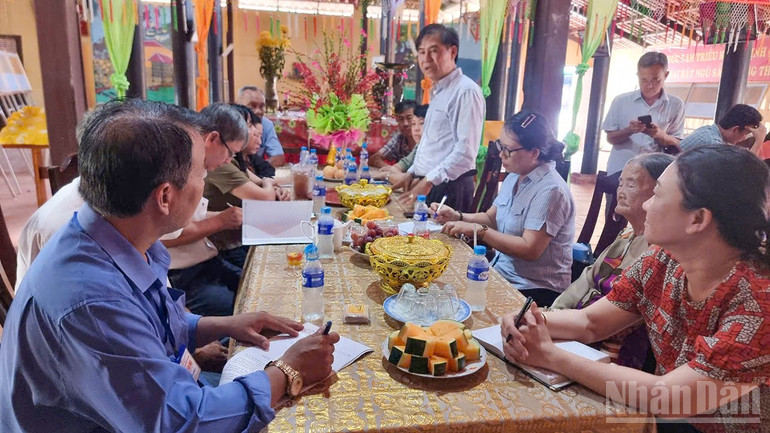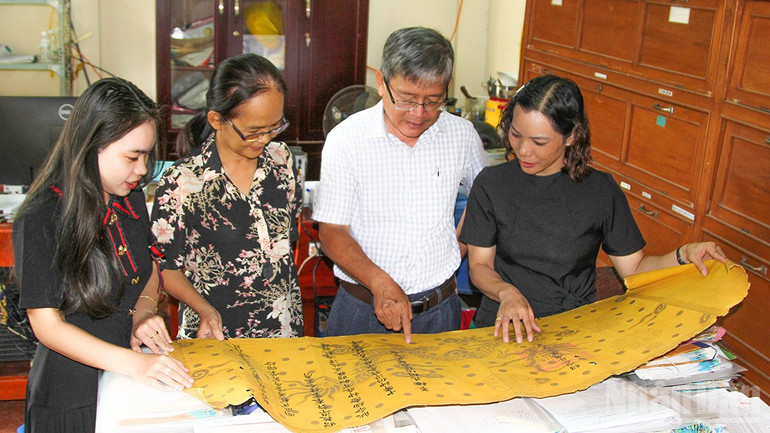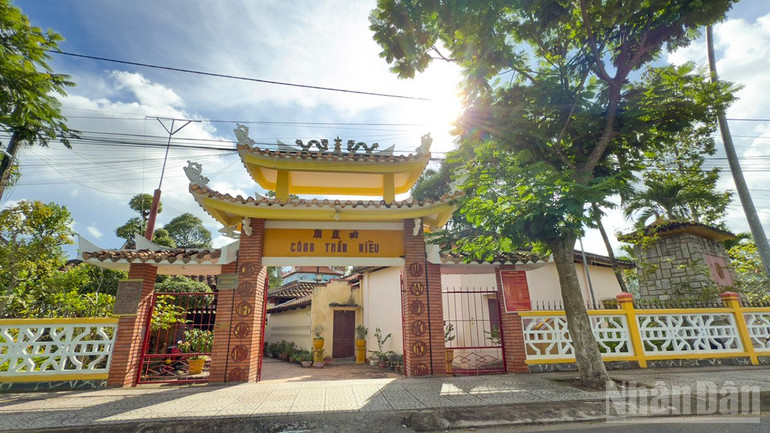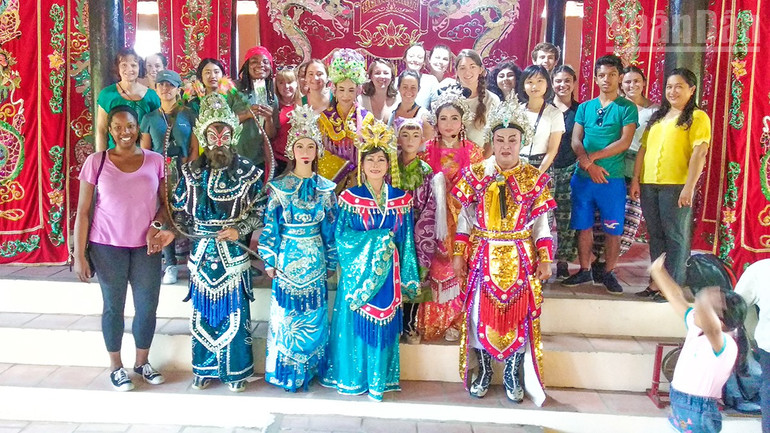
According to Dai Nam Nhat Thong Chi, the Cong Than Temple in Vinh Long was built in the 17th year of Minh Mang (1837) in Thanh My Dong village, Vinh Binh district, Vinh Long province, now Thanh Duc ward, Vinh Long province. People often call the Hoi Dong Temple Dinh Khao because the mandarins at that time often borrowed this place to organize banquets to reward their soldiers.
People preserve cultural values
According to many cultural researchers, the unique thing about Van Thanh Temple in Vinh Long is that among the 6 Council Temples of the ancient Southern Six Provinces, only 85 royal decrees in Vinh Long remain intact. The people here still preserve the forms of folk cultural activities, festivals, expressing respect and gratitude to the gods who have contributed to the country and the people.
Many documents record that the location of the Temple of Merit has changed many times, but the people still faithfully preserve the historical value of this place. In 1867, when the French colonialists had occupied 3 provinces in the West.
According to the policy of the colonial government, all citadels and residences from the district level up were destroyed. Therefore, the French colonialists destroyed the Vinh Long Council Temple and brought it back to build the Tham Bien Palace (the Governor's Palace). Fortunately, all the worshiping objects were kept intact by the people and temporarily worshiped at Thieng Duc communal house.

It was not until 1915, when Governor Pham Van Tuoi was in charge of Chau Thanh district (Vinh Long), due to the influence of the cultural protection movement initiated by the Duy Tan movement, that Mrs. Truong Thi Loan (Mrs. Y), daughter of the landlord Non, and Mrs. Le Thi Danh (wife of Governor Tuoi) stood up to campaign and submitted a petition to the Vinh Long representative requesting the re-establishment of the Council Temple.
Mrs. Truong Thi Loan donated 4,000 dong, Mr. Nguyen Van Ky donated one acre of land. On April 27, 1918, the governor of Cochinchina signed a decision allowing the construction of the temple. To avoid suspicion from the colonial government, the gentry and scholars changed the name to “Temple of the Meritorious Soldiers” until today.

Former Deputy Director of the Department of Culture, Sports and Tourism of Vinh Long province, Nguyen Xuan Hoanh, said: “To achieve this, different generations in Vinh Long have spared no effort, money and are not afraid of danger in fighting with foreign forces to preserve the cultural traditions, origins, cultural identity of the nation and many valuable artifacts.
This is the wisdom of the Vinh Long people who have recognized early the need to preserve historical and cultural values. In addition, the relic still contains many valuable historical, scientific and artistic elements. The Temple of the Gods is also an attractive subject for many fields; successive generations continue to research and explore. For these reasons, the Temple of the Gods is the pride of the majority of Vinh Long people in particular and the Mekong Delta region in general.
Preserving unique values
The Temple of the Gods was recognized as a national historical and cultural relic by the Ministry of Culture and Sports on August 31, 1998 under Decision No. 1811/1998/QD/BVHTT. Since then, the cultural sector of Vinh Long province has strengthened the preservation of the unique values here. In particular, the Vinh Long Provincial Museum has digitized the festival here to prepare a dossier to propose recognition as a national intangible cultural heritage.

The main hall of Cong Than Mieu was built in a four-pillar style, with the roof decorated with ceramic dragon motifs and cement leaf patterns. The roof was covered with yin-yang tiles, the pillars and beams were made of rosewood and thao lao, the walls were built with bricks, and the floor was tiled. Vo ca: was built in a four-pillar style, with a yin-yang tiled roof, wooden pillars, the walls were built with bricks, and the floor was tiled. Inside there was a large stage for singing to serve the people during festivals, with the east and west wings on both sides. Vo quy: connected the vo ca and the main hall, in a 3-room, 2-wing style, with a yin-yang tiled roof, wooden pillars, and tiled floors. Currently, this place still preserves many horizontal lacquered boards and parallel sentences, gilded with brilliant gold, and intricately carved.
Every year, many festivals take place at Cong Than Mieu. The main festival is the Spring Festival on the 14th, 15th and 16th of the second lunar month. During the festival, thousands of local people and people working in other places return to attend the festival.
The atmosphere of excitement, handshakes, and solemn respect clearly shows the sincerity of the masses towards the gods and ancestors. The Spring Festival is also an opportunity for associations to meet and make friends with many delegations from temples and shrines near and far.

The Spring Festival at the Temple of the Gods is also a local festival. The festival includes rituals to honor ancestors, deceased members, etc., so many people consider this to be the anniversary of their ancestors or, more importantly, to show gratitude to their founding ancestors.
Mr. Nguyen Van Sy, Head of the Management Board of the Cong Than Mieu relic, said: “Although the external architecture has deteriorated over time, the functional sector has restored and embellished many times, the internal values are still intact. We have strengthened protection measures, because this is one of the historical relics that still preserves many historical and cultural values that are difficult to find anywhere else. The cultural sector of Vinh Long province occasionally organizes opera to attract domestic and international tourists.”
Source: https://nhandan.vn/cong-than-mieu-vinh-long-noi-luu-giu-85-dao-sac-ven-nguyen-gia-tri-post906339.html



![[Photo] Politburo works with the Standing Committees of Phu Tho and Dong Nai Provincial Party Committees](https://vphoto.vietnam.vn/thumb/1200x675/vietnam/resource/IMAGE/2025/9/8/f05d30279b1c495fb2d312cb16b518b0)


![[Photo] Politburo works with the Standing Committees of Vinh Long and Thai Nguyen Provincial Party Committees](https://vphoto.vietnam.vn/thumb/1200x675/vietnam/resource/IMAGE/2025/9/8/4f046c454726499e830b662497ea1893)

![[Photo] Politburo works with the Standing Committees of Dong Thap and Quang Tri Provincial Party Committees](https://vphoto.vietnam.vn/thumb/1200x675/vietnam/resource/IMAGE/2025/9/8/3e1c690a190746faa2d4651ac6ddd01a)



















![[Photo] Prime Minister Pham Minh Chinh chairs the Government's special meeting on law making in September 2025](https://vphoto.vietnam.vn/thumb/1200x675/vietnam/resource/IMAGE/2025/9/8/fab41e764845440e957e3608afc004b9)































































Comment (0)